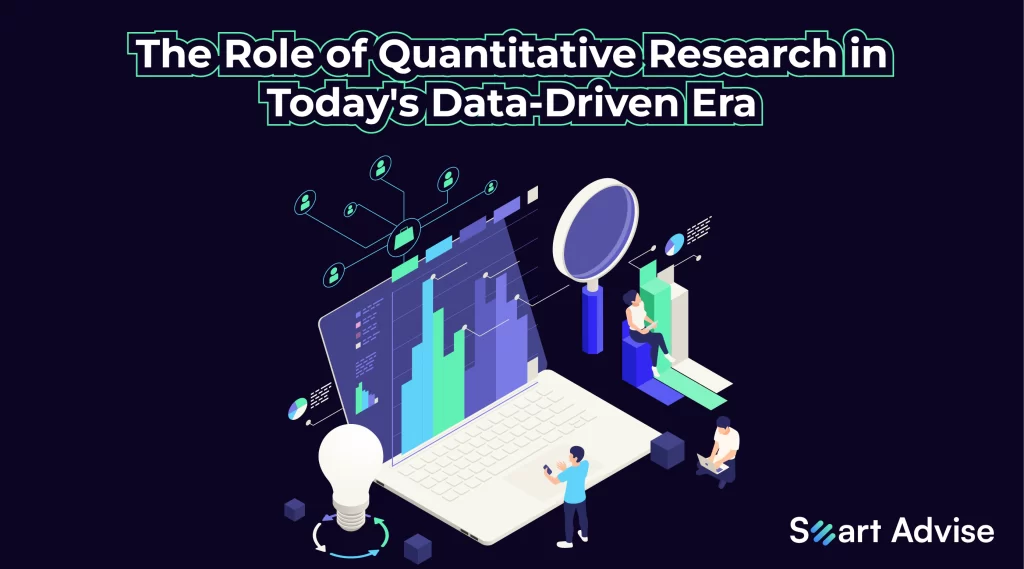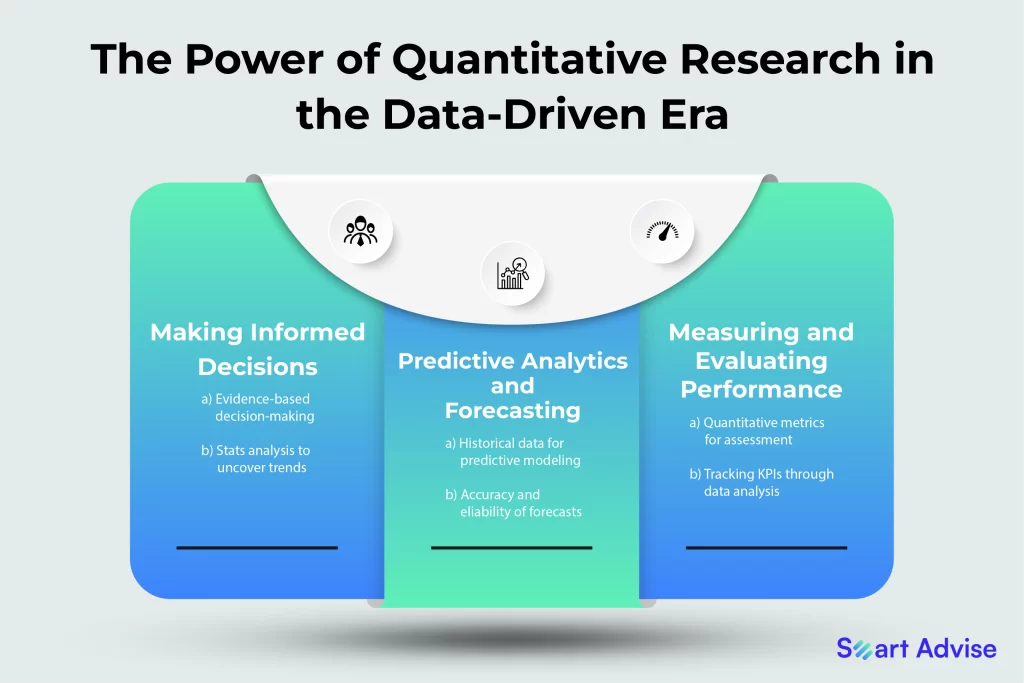
In today’s fast-paced and data-driven world, businesses face the challenge of making informed decisions that drive growth and success. This is where quantitative research plays a crucial role. By leveraging data and statistical analysis, quantitative research empowers organizations to uncover insights, predict trends, and evaluate performance. In this blog, we will explore the significance of quantitative research in today’s data-driven era and how it can shape marketing decisions. We will also introduce Smart Advise, a new-age insights firm that harnesses technology to provide agile, accurate, and actionable customer behavior insights.
Understanding Quantitative Research
Quantitative research is a systematic approach that involves collecting and analyzing numerical data to gain insights into various phenomena. This research method employs several methodologies, such as surveys, experiments, and statistical modeling, to uncover patterns, trends, and relationships within the data.
Surveys and questionnaires are commonly used in quantitative research to gather data from a large sample size. These instruments allow researchers to obtain quantitative data on people’s opinions, preferences, behaviors, and demographics. By collecting data from a diverse group, researchers can generalize their findings to a larger population.
Experiments and controlled studies are another integral part of quantitative research. These methodologies help researchers establish cause-and-effect relationships by manipulating variables and observing their impact on the outcome of interest. Through carefully designed experiments, researchers can measure the effects of specific interventions, treatments, or changes in variables.
Statistical analysis is a fundamental component of quantitative research. It involves applying mathematical and statistical techniques to the collected data to draw meaningful conclusions. Statistical analysis allows researchers to identify significant correlations, associations, and trends in the data, providing quantitative evidence to support their research objectives.
Smart Advise specializes in leveraging quantitative research methodologies to extract valuable insights for businesses. By employing surveys, experiments, and statistical modeling techniques, Smart Advise can help organizations uncover hidden patterns in customer behavior, market trends, and competitive landscapes. Their expertise in quantitative research allows them to analyze data efficiently and derive actionable insights that drive informed decision-making.
With Smart Advise’s proficiency in quantitative research, businesses can harness the power of data to gain a deeper understanding of their customers, make data-driven decisions, and shape their marketing strategies effectively.
The Power of Quantitative Research in the Data-Driven Era

- Making Informed Decisions:
In the data-driven era, decision-makers need solid evidence to support their choices. Quantitative research provides the necessary data-driven insights to make informed decisions. By collecting and analyzing numerical data, organizations can objectively assess market trends, customer preferences, and competitors’ strategies. This enables decision-makers to rely on data rather than assumptions or guesswork when formulating strategies and making important business decisions.
b. Utilizing statistical analysis to uncover trends and patterns:
Statistical analysis is a powerful tool within quantitative research that helps organizations uncover trends, patterns, and correlations within their data. By employing statistical techniques, such as regression analysis or time series analysis, businesses can identify relationships between variables, understand the impact of certain factors on outcomes, and detect emerging trends. This enables decision-makers to gain valuable insights and make data-backed decisions.
- Predictive Analytics and Forecasting:
One of the key strengths of quantitative research is its ability to leverage historical data for predictive modeling. By analyzing past data, organizations can identify patterns and trends that can be used to predict future outcomes. This enables businesses to anticipate market shifts, customer behavior, and demand patterns. By using predictive modeling techniques, such as regression analysis or machine learning algorithms, businesses can make accurate forecasts, enabling them to align their strategies with future trends and gain a competitive advantage.
b. Enhancing accuracy and reliability of forecasts:
Quantitative research techniques contribute to enhancing the accuracy and reliability of forecasts. Through rigorous data analysis and statistical modeling, businesses can reduce uncertainty and make more precise predictions. By incorporating quantitative research into their forecasting processes, organizations can make data-driven decisions, allocate resources effectively, and minimize risks associated with inaccurate predictions. This empowers decision-makers to respond proactively to market changes and optimize their strategies.
- Measuring and Evaluating Performance:
Quantitative research provides organizations with a framework to measure and evaluate their performance objectively. By defining and tracking quantitative metrics, such as sales revenue, customer acquisition rates, or website traffic, businesses can assess their progress and compare it against predefined goals. This allows decision-makers to identify areas of improvement, measure the effectiveness of marketing campaigns, and monitor overall organizational performance.
b. Tracking key performance indicators (KPIs) through data analysis:
Key Performance Indicators (KPIs) are essential metrics that reflect the success of specific business objectives. Quantitative research enables organizations to track and analyze KPIs through data analysis techniques. By regularly monitoring KPIs, businesses can gain insights into their performance, identify areas of underperformance or success, and make data-driven adjustments to improve outcomes. This allows decision-makers to stay focused on strategic goals, optimize their marketing efforts, and ensure continuous improvement.
By harnessing the power of quantitative research, organizations can make evidence-based decisions, leverage predictive analytics for accurate forecasts, and measure and evaluate performance using quantitative metrics and KPIs. Smart Advise, with its technology-driven insights, helps businesses harness the full potential of quantitative research in the data-driven era, making marketing decisions agile, accurate, and actionable. Contact us today to unlock the power of data and drive your business toward success.
Integrating Quantitative Research with Other Research Approaches
To gain a comprehensive understanding of customer behavior and market dynamics, it is crucial to complement quantitative research with qualitative research methods. While quantitative research focuses on numerical data and statistical analysis, qualitative research delves into the subjective experiences, opinions, and motivations of individuals. By combining both approaches, organizations can gain deeper insights into consumer behavior, understand the “why” behind data trends, and make more informed marketing decisions.
Quantitative research provides valuable insights into what, where, and how of consumer behavior. It helps identify patterns, trends, and correlations in large datasets, providing a broad overview of market dynamics. However, it may not always reveal the underlying reasons and motivations behind these trends. This is where qualitative research comes into play.
Qualitative research allows researchers to engage in open-ended conversations, conduct in-depth interviews, and observe consumer behavior in natural settings. It provides rich and nuanced insights into the emotions, attitudes, and preferences of individuals. By exploring the “why” behind the data, organizations can better understand consumer motivations, uncover unmet needs, and identify opportunities for innovation.
Smart Advise recognizes the value of integrating quantitative and qualitative research methods. They employ mixed methods research designs, which involve combining both approaches in a complementary manner. This holistic approach allows them to provide clients with comprehensive insights into customer behavior and market dynamics.
By leveraging mixed methods research designs, Smart Advise can triangulate data from different sources and perspectives. This not only validates findings but also offers a more nuanced understanding of the target audience. For example, they may use quantitative surveys to gather data on consumer preferences and behaviors, and then follow up with qualitative interviews to gain deeper insights into the underlying motivations and emotions driving those behaviors.
The combination of quantitative and qualitative research approaches enables organizations to make more informed marketing decisions. It helps them tailor their strategies, messaging, and product offerings to resonate with their target audience on a deeper level. By understanding the “what” and the “why” behind consumer behavior, businesses can develop more effective marketing campaigns, optimize their customer experience, and drive business growth.
In summary, integrating quantitative and qualitative research methods is essential for gaining a comprehensive understanding of customer behavior and market dynamics. Smart Advise recognizes the importance of this approach and employs mixed methods research designs to provide our clients with holistic and actionable insights. By combining the power of numbers with the richness of human experiences, organizations can make more informed and impactful marketing decisions.
Summing up
In today’s fast-paced and data-driven business landscape, quantitative research plays a vital role in enabling organizations to make informed decisions, predict trends, and evaluate performance. By leveraging data and statistical analysis, businesses can uncover valuable insights that drive growth and success. Smart Advise, a new-age insights firm, understands the significance of quantitative research in this data-driven era and utilizes advanced technology to deliver agile, accurate, and actionable customer behavior insights.
Quantitative research empowers decision-makers to make informed choices by providing evidence-based insights. It allows organizations to objectively assess market trends, customer preferences, and competitive landscapes. Through statistical analysis, businesses can identify significant correlations, associations, and trends in data, enabling them to make data-driven decisions with confidence.
The predictive analytics and forecasting capabilities of quantitative research enable organizations to leverage historical data to anticipate future outcomes. By analyzing past trends, businesses can accurately forecast market shifts, customer behavior, and demand patterns. This empowers decision-makers to align their strategies with emerging trends and gain a competitive advantage.
Quantitative research also helps organizations measure and evaluate their performance objectively. By defining and tracking quantitative metrics and key performance indicators (KPIs), businesses can assess progress, identify areas for improvement, and optimize marketing efforts. This data-driven approach ensures continuous improvement and strategic alignment.
To gain a comprehensive understanding of customer behavior and market dynamics, integrating quantitative research with qualitative research methods is essential. By combining both approaches, organizations can gain deeper insights into the “why” behind data trends, understand consumer motivations, and make more informed marketing decisions. Smart Advise employs mixed methods research designs to provide their clients with comprehensive insights, leveraging quantitative surveys, experiments, and statistical modeling, alongside qualitative interviews and observations.
Smart Advise stands out as a leading insights firm that leverages technology to enhance the agility, accuracy, and actionability of research insights. Their expertise in quantitative research, coupled with advanced data processing and analysis techniques, enables businesses to unlock the power of data in making marketing decisions. Contact Smart Advise today to harness the full potential of quantitative research and drive your business toward agility and success.
Unlock data’s potential with Smart Advise’s tech-driven insights. Create flexible and efficient marketing strategies. Stay ahead of the competition. Get in touch today!